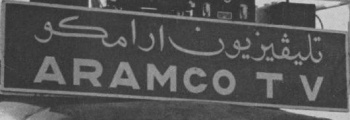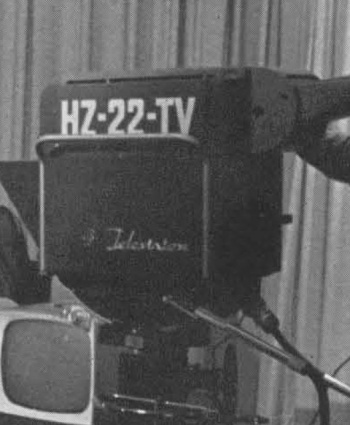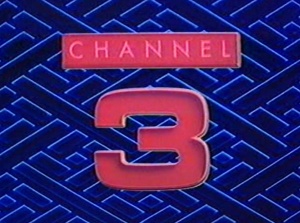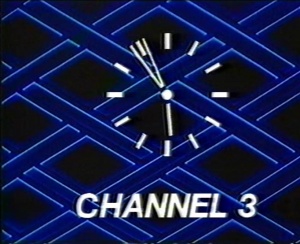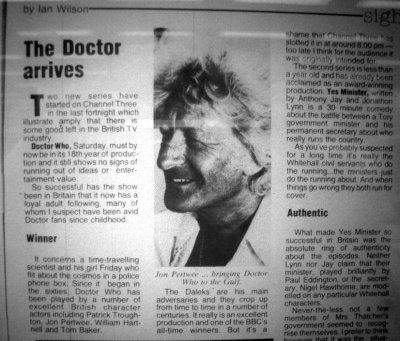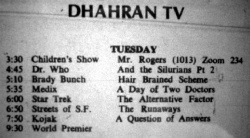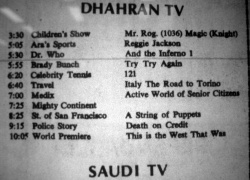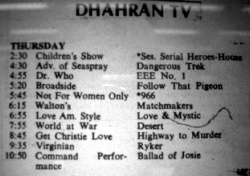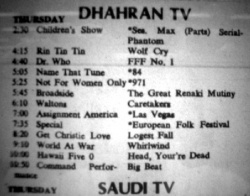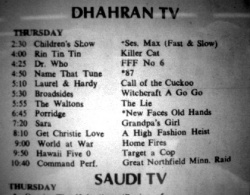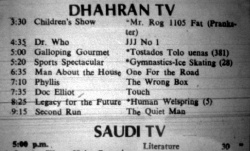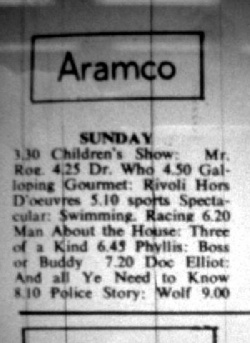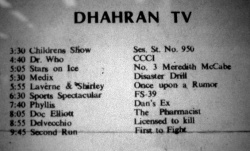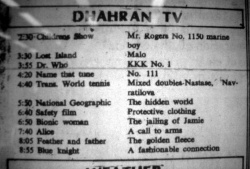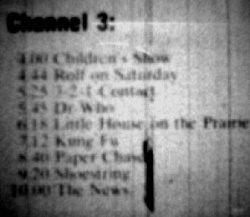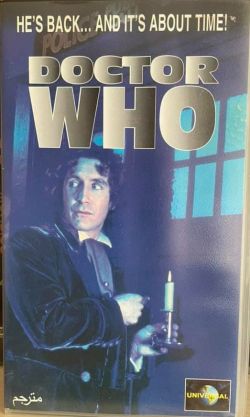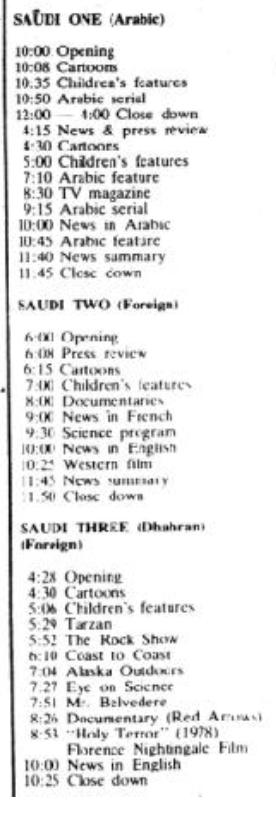Difference between revisions of "Saudi Arabia"
Jon Preddle (talk | contribs) |
Jon Preddle (talk | contribs) |
||
| (20 intermediate revisions by the same user not shown) | |||
| Line 4: | Line 4: | ||
{| {{small-table}} | {| {{small-table}} | ||
|- | |- | ||
| − | |'''Country Number (27)'''||1968 | + | |'''Country Number (27)'''||1968||[[Selling Doctor Who|FIRST, SECOND and THIRD WAVE]] |
|- | |- | ||
|'''Region'''||[[:Category:Middle East|Middle East]]|| | |'''Region'''||[[:Category:Middle East|Middle East]]|| | ||
|- | |- | ||
| − | |'''Television commenced'''||17 June 1955|| | + | |'''US AFB Television commenced'''||17 June 1955|| |
| + | |- | ||
| + | |'''Saudi Television commenced'''||17 July 1965|| | ||
|- | |- | ||
|'''Colour System 1'''||1973||[[:Wikipedia:SECAM|SECAM]] | |'''Colour System 1'''||1973||[[:Wikipedia:SECAM|SECAM]] | ||
| Line 31: | Line 33: | ||
==Television Stations / Channels== | ==Television Stations / Channels== | ||
| − | Despite its vast size, television coverage in Saudi Arabia is isolated to only two specific regions: | + | Despite its vast size, television coverage in Saudi Arabia is isolated to only two specific regions: Jidda in the west, and central Riyadh and the south eastern provinces near Dhahran on the Persian Gulf. By 1970, it had three separate broadcasters serving the country. |
'''AJL-TV''' | '''AJL-TV''' | ||
| − | The second-ever television service to the Arab world was established in Saudi Arabia; commencing from 17 June 1955, station '''AJL-TV''' went on air in Dhahran on the Arabian / Persian Gulf. This NTSC service was operated by the United States Air Force, and was intended to provide entertainment to personnel at the '''Dhahran Air Force Base'''. | + | The second-ever television service to the Arab world was established in Saudi Arabia; commencing from 17 June 1955, station '''AJL-TV''' went on air in Dhahran on the Arabian / Persian Gulf. This NTSC service was operated by the United States Air Force, and was intended to provide entertainment to personnel at the '''Dhahran Air Force Base'''. (This station was part of the American [[Armed Forces Network]].) |
| + | The base was vacated by its American personnel by the 1980s, and as far as can be determined, TV broadcasts ceased at the time. The base was manned and brought back into operation during the Gulf War crisis of 1990-1991, and television and radio transmissions resumed during the conflict. The station ceased broadcasting on 17 January 1992. | ||
| − | '''ARAMCO TV / HZ-22 | + | |
| + | '''ARAMCO TV / HZ-22 / DHAHRAN TV / CHANNEL 3''' | ||
[[File:Aramco Logo.JPG|right|thumb|350px|ARAMCO TV]] | [[File:Aramco Logo.JPG|right|thumb|350px|ARAMCO TV]] | ||
[[File:SaudiHZ22.JPG|right|thumb|350px|TV camera with HZ-22-TV label]] | [[File:SaudiHZ22.JPG|right|thumb|350px|TV camera with HZ-22-TV label]] | ||
| Line 46: | Line 50: | ||
When the new Damman station (see below) went on the air in 1970, ARAMCO ceased its [[Arabic]] service, and all subsequent broadcasts from HZ-22 / channel 2 were in English. | When the new Damman station (see below) went on the air in 1970, ARAMCO ceased its [[Arabic]] service, and all subsequent broadcasts from HZ-22 / channel 2 were in English. | ||
| − | [[File:SACh3Ident1.JPG|right|thumb|300px|Screen grab of Saudi's | + | [[File:SACh3Ident1.JPG|right|thumb|300px|Screen grab of Saudi's Channel 3 ident from 1987]] |
[[File:SACh3Ident2.JPG|right|thumb|300px|Screen grab of Saudi's PAL colour Channel 3 ident from 1987]] | [[File:SACh3Ident2.JPG|right|thumb|300px|Screen grab of Saudi's PAL colour Channel 3 ident from 1987]] | ||
In November 1976, ARAMCO modified its monochrome 525-line transmitters to broadcast in NTSC colour. Three years later, in March 1979, it installed a PAL colour transmitter which brought compatibility to the station and the neighbouring gulf nations ([[Bahrain]], [[United Arab Emirates]], [[Kuwait]]) that were already broadcasting in PAL. This PAL colour station was simply called '''Channel 3'''. | In November 1976, ARAMCO modified its monochrome 525-line transmitters to broadcast in NTSC colour. Three years later, in March 1979, it installed a PAL colour transmitter which brought compatibility to the station and the neighbouring gulf nations ([[Bahrain]], [[United Arab Emirates]], [[Kuwait]]) that were already broadcasting in PAL. This PAL colour station was simply called '''Channel 3'''. | ||
| − | + | '''Doctor Who''' aired on ARAMCO TV's PAL Channel 3 between 1977 and 1982. | |
| − | |||
| − | '''Doctor Who''' aired on ARAMCO TV's PAL Channel 3 between 1977 and 1982 | ||
| − | The ARAMCO | + | The ARAMCO stations eventually closed in 1998. |
These sites contain further information about ARAMCO: | These sites contain further information about ARAMCO: | ||
| Line 65: | Line 67: | ||
'''SAUDI TV''' | '''SAUDI TV''' | ||
| − | The Saudi government's '''Ministry of Information''' began its own television broadcasts from Riyadh and Jidda from 17 July 1965. | + | The Saudi government's '''Ministry of Information''' began its own television broadcasts from Riyadh in central Saudi (on channel 5), and Jidda / Jeddah on the Red Sea (channel 10) from 17 July 1965, operating two language frequencies, one in [[Arabic]], the other English. |
| + | |||
| + | By August 1967, the Jidda signal was extended by microwave link and satellite transmitters to reach the nearby cities of Mecca (channel 7) and Taif (channel 8). By late 1968, the Jidda / Mecca / Taif 'network' was automated, with operations run out of Jidda. | ||
| + | |||
| + | A further television service was established in Medina, north of Jidda (channel 5, which commenced broadcasts on 30 December 1967), and another in Buraydah, in the Kassim / Quassim / Al Qassim district of central Saudi, northwest of Riyadh (channel 8 commenced on 14 July 1968). These two remote stations were not linked by microwave, but instead broadcast from video-taped or kinescoped film copies of programmes: Medina received these recordings from Jidda, while Buraydah was supplied by Riyadh. | ||
| + | |||
| + | A seventh station in Damman on the Arabian / Persian Gulf was established from 5 November 1969 (channel 6), and an eighth, based in Abha, went online in 1977. | ||
Colour transmissions on '''Saudi TV''' began in 1973 using the [[Wikipedia:SECAM|SECAM]] colour broadcast system. | Colour transmissions on '''Saudi TV''' began in 1973 using the [[Wikipedia:SECAM|SECAM]] colour broadcast system. | ||
| Line 74: | Line 82: | ||
'''OTHER STATIONS''' | '''OTHER STATIONS''' | ||
| − | + | Saudi viewers purchased dual-standard television sets to enable them to enjoy broadcasts coming from all the different Gulf stations, as all were broadcasting in different formats. | |
| − | |||
| − | Saudi viewers purchased dual-standard television sets to enable them to enjoy broadcasts coming from all the different stations, as all were broadcasting in different formats. | ||
Broadcasts from [[Kuwait]] could also be received in eastern Saudi Arabia, and from 1973, colour transmissions from [[Bahrain]] could also be received. | Broadcasts from [[Kuwait]] could also be received in eastern Saudi Arabia, and from 1973, colour transmissions from [[Bahrain]] could also be received. | ||
Transmissions from the [[United Arab Emirates]] could also at times also be received. | Transmissions from the [[United Arab Emirates]] could also at times also be received. | ||
| + | |||
| + | During the 1980s and early 1990s, satellite and cable stations became available in Saudi Arabia. '''Doctor Who''' may have aired on an unidentified satellite station during the late 1980s. | ||
| Line 93: | Line 101: | ||
{{Arabic}} | {{Arabic}} | ||
| − | Saudi Arabia was the '''27th''' country to screen '''Doctor Who'''; it was the '''third''' to screen the series in [[Arabic]] (see [[Selling Doctor Who]]). | + | Saudi Arabia was approximately the '''27th''' country to screen '''Doctor Who'''; it was the '''third''' to screen the series in [[Arabic]] (see [[Selling Doctor Who]]). |
==[[BBC Records]]== | ==[[BBC Records]]== | ||
| + | |||
| + | Saudi Arabia is named in the list of 27 countries in '''The Making of Doctor Who''' (1972 Piccolo edition). | ||
'''The Seventies''' records a sale of '''"(4)"''' stories by 28 February 1977. '''The Handbook''' identifies these as being: {{C}}, {{E}}, {{J}} and {{L}}. | '''The Seventies''' records a sale of '''"(4)"''' stories by 28 February 1977. '''The Handbook''' identifies these as being: {{C}}, {{E}}, {{J}} and {{L}}. | ||
| Line 135: | Line 145: | ||
|} | |} | ||
| − | Saudi Arabia therefore bought the standard package of GROUP A, B and C of the [[William Hartnell stories]] dubbed into [[Arabic]]. | + | Saudi Arabia therefore bought the standard package of GROUP A, B and C of the [[William Hartnell stories]] dubbed into [[Arabic]]. Only episode 1 of [[An Unearthly Child]] was sold. BBC sales documents record that the clearances for Saudi Arabia were paid out on '''27 and 28 May 1968'''. |
| + | |||
| + | The programme was supplied as 16mm black and white film prints with [[Arabic]] soundtracks. It is possible that the broadcaster was also supplied with English prints, enabling a simulcast in both languages, with the English soundtrack available on the radio. | ||
====Origin of the Prints?==== | ====Origin of the Prints?==== | ||
| − | [[Tunisia]] and [[Morocco]] had screened the Hartnell stories | + | [[Tunisia]] and [[Morocco]] had screened the Hartnell stories from 1967 to 1968 (exact dates for the latter country are not known) so it's possible the prints sent to Saudi Arabia came from one of these two countries, if not a fresh set direct from the BBC itself. (Saudi Arabia was also a distribution client of '''[[TIE Ltd|Television International Enterprises Ltd / TIE (Programmes) Ltd]]''', who had previously supplied prints (in English) to [[Aden]].) |
| − | |||
| − | |||
| Line 205: | Line 215: | ||
(Other BBC records indicate that the sale of [[The Three Doctors]] was "CANCELLED"; Strict Saudi censorship did not permit programmes that featured "god-like" beings, of which Omega may have been considered; [[The Green Death]] was never offered, possibly on account of its strong views against oil pollution...; and [[Invasion of the Dinosaurs]] was not available at all.) | (Other BBC records indicate that the sale of [[The Three Doctors]] was "CANCELLED"; Strict Saudi censorship did not permit programmes that featured "god-like" beings, of which Omega may have been considered; [[The Green Death]] was never offered, possibly on account of its strong views against oil pollution...; and [[Invasion of the Dinosaurs]] was not available at all.) | ||
| − | ARAMCO was broadcasting in NTSC colour from 1976 | + | ====Origin of the Prints?==== |
| + | |||
| + | Although ARAMCO was broadcasting in NTSC colour from 1976, it's not readily clear whether these episodes aired in black and white or colour. | ||
| + | |||
| + | U-Matic colour video tapes were in common usage by ARAMCO in the 1970s, so it is feasible that the BBC supplied ARAMCO with the first four Pertwee seasons in NTSC on that format, rather than as monochrome film. However, the TV listings seem to denote colour programmes with an asterisk (*) and none of the '''Doctor Who''' listings are marked as such, which does suggest that, like much of the TV schedules at that time, these were in black and white. | ||
| + | |||
| + | If they were on film, the season seven stories were probably supplied new directly by the BBC, while some of the season eight and nine black and white prints may have been from the set that had been returned by [[Australia]] in 1975, with the season ten stories supplied from [[Gibraltar]], where they had aired in early 1977. | ||
ARAMCO commenced PAL colour broadcasts after 1979. The final four season 11 stories would have been supplied on PAL colour video tape in English. | ARAMCO commenced PAL colour broadcasts after 1979. The final four season 11 stories would have been supplied on PAL colour video tape in English. | ||
| + | |||
| + | The BBC's master tape of [[Death to the Daleks]] episode 1 was no longer held by them in 1978, so the tapes supplied to ARAMCO had to be from a set that was already in circulation. | ||
===[[Tom Baker stories|TOM BAKER]]=== | ===[[Tom Baker stories|TOM BAKER]]=== | ||
| − | ''' | + | '''UNKNOWN TV STATION (NTSC) *([[Armed Forces Network]]?)''' |
| − | 23 stories, equivalent of 98 episodes edited into "omnibus" movies: | + | 22 or 23 stories, equivalent of 94/98 episodes edited into "omnibus" movies: |
<div style="float:left;"> | <div style="float:left;"> | ||
| Line 223: | Line 241: | ||
|4B||[[The Sontaran Experiment]]||2 | |4B||[[The Sontaran Experiment]]||2 | ||
|- | |- | ||
| − | |4C||[[The Ark in Space]]||4 | + | |4C||[[The Ark in Space]] ##||4 |
|- | |- | ||
|4D||[[Revenge of the Cybermen]]||4 | |4D||[[Revenge of the Cybermen]]||4 | ||
| Line 276: | Line 294: | ||
<br /> | <br /> | ||
| + | An unidentified satellite or cable station screened the standard package of [[Tom Baker stories]] that had been edited into omnibus "movies" that was distributed by Lionheart. (As noted below, these still had some of the old Howard da Silva narrations in place.) | ||
| − | + | The programmes would have been supplied on NTSC colour video tape in English. | |
| − | The | + | *(##) [[The Ark in Space]] was not included in the package of "movies" supplied by the AFRTS, so if this unknown Saudi station ''is'' AFRTS, then this 4-parter was not part of the run. |
| − | '''ARAMCO – Channel 3 (PAL)''' | + | '''ARAMCO – English Channel 3 (PAL)''' |
Potentially 18 stories, equivalent of 74 episodes edited into "omnibus" movies: | Potentially 18 stories, equivalent of 74 episodes edited into "omnibus" movies: | ||
| Line 307: | Line 326: | ||
|5G||[[The Creature from the Pit]]||4 | |5G||[[The Creature from the Pit]]||4 | ||
|- | |- | ||
| − | |} | + | |} |
</div> | </div> | ||
| − | <div style="float:right; width: | + | <div style="float:right; width:60%;"> |
{| {{small-table}} | {| {{small-table}} | ||
|- | |- | ||
| Line 333: | Line 352: | ||
|} | |} | ||
</div> | </div> | ||
| + | <br / clear="all"> | ||
| + | <br /> | ||
| − | ARAMCO | + | ARAMCO appears to have bought the remaining [[Tom Baker stories]] (or maybe only some of them), and aired them as "omnibus" editions. |
It is possible that the "(4)" stories sold by February 1987 as noted in '''The Eighties''' might relate solely to the PAL episodes - in which case, and on the basis that one of them was [[Full Circle]] (as covered below) - the stories that aired in Saudi Arabia in the mid/late 1980s might be from season 18 only… | It is possible that the "(4)" stories sold by February 1987 as noted in '''The Eighties''' might relate solely to the PAL episodes - in which case, and on the basis that one of them was [[Full Circle]] (as covered below) - the stories that aired in Saudi Arabia in the mid/late 1980s might be from season 18 only… | ||
| − | Although the sale itself was probably still handled by Lionheart, the tapes supplied in the PAL format in English were likely sourced from the [[United Arab Emirates]], where those stories were screening episodically at the time. (It would seem that ARAMCO edited the stories into "movies" themselves | + | Although the sale itself was probably still handled by Lionheart, the tapes supplied in the PAL format in English were likely sourced from the [[United Arab Emirates]], where those stories were screening episodically at the time. (It would seem that ARAMCO may have edited the stories into "movies" themselves.) |
| Line 345: | Line 366: | ||
===[[William Hartnell stories|WILLIAM HARTNELL]]=== | ===[[William Hartnell stories|WILLIAM HARTNELL]]=== | ||
| − | |||
| − | The series would have | + | The [[Arabic]]-dubbed episodes of '''Doctor Who''' aired several times on a regional basis in Saudi Arabia, from circa '''mid-1968''' until '''early to mid-1969'''. |
| + | |||
| + | We have not been able to access Saudi Arabian newspapers from the late 1960s, and therefore do not have any firm transmission dates. | ||
| + | |||
| + | According to his book ''[http://books.google.co.uk/books?id=zX6CBAAAQBAJ&q=dr+who#v=snippet&q=dr%20who&f=false Half Past Ten in the Afternoon''] (Arabian Publishing, 2014), author James Budd (who lived in Saudi Arabia from 1965 to 1970) recalls that he "bought a television set in 1968 when al-Gassim TV [sic] first went on air for a few hours a day in the evenings … Later, a dubbed version of ''Dr Who'' arrived on our screens." | ||
| + | |||
| + | As noted above, the TV station in Buraydah commenced broadcasts on 14 July 1968, which does give us a firm date for when Budd acquired his TV set. Since the Kassim channel received video or film copies from Riyadh, sufficient time has to be allowed for the recordings to be delivered to and scheduled by the remote station. Budd says '''Doctor Who''' aired "later", so with 37 episodes stripped on a weekly basis we are looking at the series potentially playing on that channel from around '''late 1968''' through until '''early 1969''', which means the Riyadh screenings would have been a few days or weeks (perhaps even months?) earlier. | ||
| + | |||
| + | From all the available information, we can conclude that the nine '''Doctor Who''' serials sold to Saudi Arabia aired at least '''five times''' each, although the order in which these screenings occurred is not known: there was one screening on the Jidda / Mecca / Taif network, with tape / film copies supplied to Medina; and one screening on the Riyadh channel, followed by regional screenings in Kassim and Damman using video or film copies. These five regional screenings started circa '''mid-1968''' and ended circa '''early to mid-1969'''. | ||
====Fate of the Prints?==== | ====Fate of the Prints?==== | ||
| − | [[Jordan]] was the next [[Arabic]] country in the [[:Category:Middle East|Middle East]] to | + | [[Jordan]] was the next [[Arabic]] country in the [[:Category:Middle East|Middle East]] to purchase '''Doctor Who''' (from mid-1969). Even without any firm airdates for either the Saudi or the Jordan screenings, it's highly likely that Saudi Arabia sent its prints of the Hartnell stories to [[Jordan]]. |
. | . | ||
| Line 359: | Line 387: | ||
===[[Jon Pertwee stories|JON PERTWEE]]=== | ===[[Jon Pertwee stories|JON PERTWEE]]=== | ||
[[File:Saudi BBB2.JPG|thumb|right|250px|And The Silurians Part 2, Arab Times, 3 May 1977, Arab Times]] | [[File:Saudi BBB2.JPG|thumb|right|250px|And The Silurians Part 2, Arab Times, 3 May 1977, Arab Times]] | ||
| + | [[File:SaudiDDD1.JPG|right|thumb|250px|"… and the Inferno", ep 1; 14 June 1977]] | ||
[[File:Saudi EEE.JPG| thumb|right|250px|Terror of the Autons, Part One, Arab Times, 11 August 1977 – NOTE programmes marked with a * probably in COLOUR]] | [[File:Saudi EEE.JPG| thumb|right|250px|Terror of the Autons, Part One, Arab Times, 11 August 1977 – NOTE programmes marked with a * probably in COLOUR]] | ||
[[File:Saudi FFF.JPG| thumb|right|250px|The Mind of Evil, Arab Times, 8 September 1977 - NOTE programmes marked with a * probably in COLOUR]] | [[File:Saudi FFF.JPG| thumb|right|250px|The Mind of Evil, Arab Times, 8 September 1977 - NOTE programmes marked with a * probably in COLOUR]] | ||
| Line 364: | Line 393: | ||
[[File:Saudi JJJ.JPG| thumb|right|250px|The Daemons, Part One, Arab Times, October 1977 - NOTE programmes marked with a * probably in COLOUR]] | [[File:Saudi JJJ.JPG| thumb|right|250px|The Daemons, Part One, Arab Times, October 1977 - NOTE programmes marked with a * probably in COLOUR]] | ||
[[File:Saudi Aramco.JPG| thumb|right|250px|Generic Sunday listing (Pertwee) ARAMCO TV, Gulf Mirror, 1977]] | [[File:Saudi Aramco.JPG| thumb|right|250px|Generic Sunday listing (Pertwee) ARAMCO TV, Gulf Mirror, 1977]] | ||
| + | [[File:SaudiCCC1.JPG |right|thumb|250px|The Ambassadors of Death ep 1; 8 January 1978]] | ||
| + | [[File:SaudiDuplication.JPG|right|thumb|250px|The first of the duplicated TV listings showing KKK No 1 (15 March 1978)]] | ||
| + | |||
[[File:Saudi Ch3.JPG| thumb|right|250px|Generic listing (Pertwee), Channel 3, Gulf Mirror, January 1982]] | [[File:Saudi Ch3.JPG| thumb|right|250px|Generic listing (Pertwee), Channel 3, Gulf Mirror, January 1982]] | ||
Nine or so years after the William Hartnell Doctor featured on Saudi TV screens, the good Doctor returned in 1977 – now played by Jon Pertwee. | Nine or so years after the William Hartnell Doctor featured on Saudi TV screens, the good Doctor returned in 1977 – now played by Jon Pertwee. | ||
| − | The newspaper listings are a bit erratic from mid 1976 until the start of 1977, so we are uncertain as to the exact start date for the Jon Pertwee run, but the first clear listing is for part two of [[Doctor Who and the Silurians]] on Tuesday, '''26 April 1977''' on '''DHAHRAN TV''' (i.e. '''ARAMCO'''). (This start is only a few days after the brief run of Pertwee episodes commenced in [[Lebanon]]) | + | The newspaper listings are a bit erratic from mid 1976 until the start of 1977, so we are uncertain as to the exact start date for the Jon Pertwee run, but the first clear listing is for part two of [[Doctor Who and the Silurians]] on Tuesday, '''26 April 1977''' on '''DHAHRAN TV''' (i.e. '''ARAMCO'''). (This start is only a few days after the brief run of Pertwee episodes commenced in [[Lebanon]].) The timeslots fluctuated, with the earliest at 4.45pm and the latest 5.55pm. |
ARAMCO had dropped its Arabic programming in 1970, so these episodes were all broadcast in English. They were (most likely) also in black and white. | ARAMCO had dropped its Arabic programming in 1970, so these episodes were all broadcast in English. They were (most likely) also in black and white. | ||
| Line 376: | Line 408: | ||
There were two dates on which episodes did not air – 2 August 1977 and 22 September 1977; however the accuracy of the listings is under question for reasons outlined below. | There were two dates on which episodes did not air – 2 August 1977 and 22 September 1977; however the accuracy of the listings is under question for reasons outlined below. | ||
| − | The series did not screen in correct story order; in fact it looks very much as though the schedulers played the serials according to "theme" – it seems ARAMCO may have run the first seven stories featuring Roger Delgado as the Master (from seasons 8 and 9) in a 'block' (there are certainly enough airdates for this to have been the case), followed by [[The Ambassadors of Death]], then the first two Pertwee Daleks stories back to back, with a four-parter ([[Spearhead from Space]], [[The Curse of Peladon]] | + | The series did not screen in correct story order; in fact it looks very much as though the schedulers played the serials according to "theme" – it seems ARAMCO may have run the first seven stories featuring Roger Delgado as the Master (from seasons 8 and 9) in a 'block' (there are certainly enough airdates for this to have been the case), followed by [[The Ambassadors of Death]], then the first two Pertwee Daleks stories back to back, with a four-parter ([[Spearhead from Space]], [[The Curse of Peladon]] or [[Carnival of Monsters]]?) to finish. |
| − | The only ten stories are identified by title or story code: [[Doctor Who and the Silurians]], {{CCC}}, [[Inferno]], {{EEE}}, {{FFF}}, {{GGG}}, {{HHH}}, {{JJJ}}, {{KKK}} | + | The only ten stories are identified by title or story code: [[Doctor Who and the Silurians]], {{CCC}}, [[Inferno]], {{EEE}}, {{FFF}}, {{GGG}}, {{HHH}}, {{JJJ}}, {{KKK}} and {{SSS}}, which accounts for 56 episodes. |
| − | + | Two unidentified 6-parters aired in November and December 1977. Given the themed stories that aired either side of these, they would (presumably) be ones to feature the Master, so likely [[The Sea Devils]] or [[The Time Monster]], or possibly [[Frontier in Space]] (which may have aired later, in July 1978). | |
| − | + | According to the ''Gulf Mirror'', the run lasted for at least 72 episodes, and concluded on Sunday, '''19 March 1978'''. However, the ''Arab Times'' continued to list the series until '''22 April 1978''' – but for reasons outlined below, we have reason to doubt the complete accuracy of these ''Times'' listings. | |
| − | NOTE: There were no ARAMCO listings for '''Doctor Who''' in the ''Gulf Mirror'' between 20 April 1978 and 8 July 1978; however given that we are short | + | A new run of only six episodes aired from Saturday, '''8 July 1978''', at 4.40pm. Again, no titles were given; but presumably this 6-parter was [[Frontier in Space]], as that was the only other Master-themed 6-parter not identified during the previous run. (The other options are for this run to be [[The Sea Devils]], [[The Mutants]] or [[The Time Monster]].) |
| + | |||
| + | NOTE: There were no ARAMCO listings for '''Doctor Who''' in the ''Gulf Mirror'' between 20 April 1978 and 8 July 1978; however given that we are potentially short 14 episodes, it is possible that these "missing" episodes aired during that time. From 22 April, the usual '''Doctor Who''' slot was taken by the American comedy '''Dennis the Menace''', but the accuracy of those listings is under question... | ||
After a three year break, the series returned, now on the newly-established PAL colour '''Channel 3'''. The first episode was at 8.04pm on Saturday, '''21 November 1981'''. This slot moved around a bit during the run, with 5.54 or 5.45pm being the two most common. | After a three year break, the series returned, now on the newly-established PAL colour '''Channel 3'''. The first episode was at 8.04pm on Saturday, '''21 November 1981'''. This slot moved around a bit during the run, with 5.54 or 5.45pm being the two most common. | ||
| Line 394: | Line 428: | ||
The last recorded Channel 3 episode was on '''3 April 1982'''. | The last recorded Channel 3 episode was on '''3 April 1982'''. | ||
| − | Assuming ARAMCO purchased all the available Pertwee stories, there are | + | Assuming ARAMCO purchased all the available Pertwee stories, there are 14 episodes not accounted for – two 4-parters (two from the list of [[Spearhead from Space]], [[The Curse of Peladon]] and [[Carnival of Monsters]]) and one 6-parter. The first run was for (at least) 72 weeks/episodes; the second only six, and the third and last for 20. That is only 98 out of a potential 112. It is possible that [[Spearhead from Space]] didn't screen at all – there is no listing for it ahead of [[Doctor Who and the Silurians]] – which potentially leaves just one 4-parter and one 6-parter unaccounted for. |
| − | + | But since accurate TV listings between 19 March and 8 July 1978 are not available, it's highly likely the "missing" 14 episodes aired during that four month period. | |
| − | Saudi Arabia appears to be the last-ever country to screen a full run of season 7 to 10 Jon Pertwee stories from black and white film. With the exception of [[Bangladesh]], who aired a handful in black and white in 1980, all other countries screened what was then left of the third Doctor stories still in PAL colour. | + | ====Fate of the Prints / Tapes?==== |
| + | |||
| + | Saudi Arabia appears to be the last-ever country to screen a full run of season 7 to 10 Jon Pertwee stories from black and white film. | ||
| + | |||
| + | (Saudi may have lent its prints of [[Spearhead from Space]], [[Doctor Who and the Silurians]] and [[The Ambassadors of Death]] to [[Lebanon]]. If so, they would have been sent back to Saudi Arabia after broadcast.) | ||
| + | |||
| + | With the exception of [[Bangladesh]], who aired a handful in black and white in 1980, all other countries screened what was then left of the third Doctor stories still in PAL colour. | ||
| + | |||
| + | In late 1981 / early 1982, a number of '''Doctor Who''' films that had been returned from an overseas station were reportedly destroyed by the BBC. Given that Saudi Arabia had finished its run of 16mm film prints by then, it is a very good chance that these destroyed episodes came from Saudi Arabia. | ||
. | . | ||
| Line 406: | Line 448: | ||
===[[Tom Baker stories|TOM BAKER]]=== | ===[[Tom Baker stories|TOM BAKER]]=== | ||
| − | "Omnibus" editions of Tom Baker stories, [[Robot]] through to [[The Invasion of Time]], aired on | + | "Omnibus" editions of Tom Baker stories, [[Robot]] through to [[The Invasion of Time]] (but minus [[The Ark in Space]]?), aired on an unidentified NTSC channel which does not feature in any newspaper TV listings. It may have been a satellite or cable channel, possibly via the United States. |
| + | |||
| + | Our eye-witness (see below) recalls that the station might have been called '''Star''', but our investigations have drawn a blank on this name. (The main TV station in [[Aden]] was the '''South Arabian Television Service (SATS)'''. While it's possible that "SATS" could be the mysterious "Star", it's extremely unlikely - given its geographical position and distance - that signals from Aden could reach the north eastern regions of Saudi Arabia. Our witness might however indeed be thinking of SATS, but in a different context.) | ||
| + | |||
| + | It's far more likely that these broadcasts were by the '''[[Armed Forces Network|United States Armed Forces Radio and Television, (aka AFRTS)]]''', which is almost an anagram of "Star". Although the US bases were closed down and all troops were mostly vacated during the mid-1980s, the TV station may have still been operating albeit at a reduced capacity | ||
| − | We do not have confirmed airdates for these broadcasts, but | + | We do not have confirmed airdates for these broadcasts, but an eye-witness who actually watched them at the time tells us that the stories aired around '''mid-1985''' to '''early 1986''' (which certainly ties in with at least four stories having been sold by February 1987, per '''The Eighties'''). |
| − | One surprising recollection made by our viewer is that one short scene in the movie omnibus of [[Underworld]] retained a brief section of the old Howard da Silva narration (added to the episodes by the [[United States]] distributor in 1978), but which was accidentally left in when the episodes were re-edited into their "movie" omnibus editions in 1981. The voice-over says: "The signal from the missing ship grows stronger as the crew plummets to the underworld". This confirms that | + | One surprising recollection made by our viewer is that one short scene in the movie omnibus of [[Underworld]] retained a brief section of the old Howard da Silva narration (added to the episodes by the [[United States]] distributor in 1978), but which was accidentally left in when the episodes were re-edited into their "movie" omnibus editions in 1981 for Lionheart. The voice-over says: "The signal from the missing ship grows stronger as the crew plummets to the underworld". This confirms that NTSC tapes or the transmissions if via satellite were possibly sourced from the [[United States]]. (See the [[Underworld]] page for a clip with this narration.) |
(See also [http://chicago.epguides.com/DoctorWho/variations.aspx UNDERWORLD VARIATIONS] for more about these variations (scroll down to 1991).) | (See also [http://chicago.epguides.com/DoctorWho/variations.aspx UNDERWORLD VARIATIONS] for more about these variations (scroll down to 1991).) | ||
| − | + | Around the time that these NTSC omnibuses of fourth Doctor stories had concluded, ARAMCO started screening its own run of PAL omnibuses of fourth Doctor stories. (Or there may even have been a brief period of overlap when the two channels were screening '''Doctor Who''' at the same time.) | |
The only story known to have definitely aired was [[Full Circle]], circa '''May or June 1986'''. | The only story known to have definitely aired was [[Full Circle]], circa '''May or June 1986'''. | ||
| − | Our man on the scene says: ''"It is possible that both channels were airing '''Doctor Who''' simultaneously: the NTSC ones | + | :Our man on the scene says: ''"It is possible that both channels were airing '''Doctor Who''' simultaneously: the NTSC ones had finished broadcasting by the time I got out to Saudi - my father recorded them so these were probably on during early 1986 but [[Full Circle]] on Channel 3 - as it is on one of my tapes - must have been while I was out there in the summer (May-June)." '' |
| + | |||
| + | :''"I don't know if this was a local case of bicycling - season 18 being shown in the [[United Arab Emirates|UAE]] (e.g. [[Meglos]]) then the tapes being sent onto Saudi 3 very shortly after (e.g. [[Full Circle]]) - but the NTSC tapes probably may have come via America (remember that snippet of Howard da Silva narration I mentioned appearing on [[Underworld]]) and not via the usual UK sales."'' | ||
| + | |||
| + | :''"Saudi 1 was the more technically primitive, as I recall, and was probably broadcasting from the capital Riyadh, which I never got to visit … Saudi 3 was, I think, broadcasting from the Dhahran region, and the quality of transmission was usually superb."'' | ||
| + | |||
| + | From this information, it seems that Tom Baker stories aired in Saudi Arabia from: | ||
| + | *'''mid-1985''' to '''early 1986''' - [[Robot]] to [[The Invasion of Time]] - on our mystery NTSC station (possibly [[AFRTS]]), and then: | ||
| + | *'''early 1986''' (and on into '''1987'''?) - [[The Ribos Operation]]? to [[Logopolis]]? – in PAL on ARAMCO's Channel 3 | ||
| − | + | Unfortunately, as noted below, we have been unable to find clear TV listings to back this up… | |
| + | {{clear}} | ||
| − | + | ==Merchandise== | |
| − | + | ===VIDEO TAPES (PAUL McGANN)=== | |
| − | + | [[File:TVMSaudiArabia.jpg|right|thumb|250px|Cover of Saudi Arabian VHS tape]] | |
| − | |||
| + | The 1996 Paul McGann [[TV Movie]] was released on VHS in Saudi Arabia circa '''late 1996'''. | ||
| + | |||
| + | The subtitled tape was published by MCA/Universal/CIC Video and Ghassan Production & Distribution Ltd (a company based in Jeddah) under its "Video Master" brand (the "VM" logo appears on the spine). | ||
| + | |||
| + | The tape box features the title '''DOCTOR WHO''' in English (on the front, spine and back), in a font that is quite different to the usual styling that appears on most other tapes of the Movie. | ||
| + | |||
| + | The only Arabic text on the front is the word for "Subtitled" (in the bottom left corner). On the back of the box, the bulk of the text - the story synopsis and copyright disclaimers and address of the distributor - is all in English. The same disclaimers and addresses (plus the "file" date) are also written in Arabic. | ||
| + | |||
| + | Other Arabic text states the film was filed at the Ministry of Media on "١٤١٧/٥/١٧" ("1417/5/17"). This dating style is that of the Hijri Calendar (reads right to left), which converts as "01/10/1996" in the Gregorian calendar, but this is not necessarily also the release date. (The film was therefore available for sale / rental from late 1996 or early 1997.) | ||
| + | |||
| + | Of note, the tape includes trailers for several upcoming theatrical releases, including '''"Star Trek First Contact"''', which opened in the US in November 1996, and in the UK and Europe a month later. | ||
| + | |||
| + | Hard-line religious clerics in Saudi Arabia had forced the closure of all cinemas in the early 1980s, and it wasn't until 2018, as part of a far-reaching liberalisation drive, that movie theatres re-opened, so while it's possible these trailers were loaded on the original video master tape by MCA/Universal and they therefore appeared on all tapes irrespective of location, if these trailers were added by the distributor for non-Saudi audiences, then the Video Master tape may have also been intended for the wider Arabic market and therefore distributed to other Middle Eastern countries. | ||
| + | {{clear}} | ||
==TV listings== | ==TV listings== | ||
| + | |||
{{airdates-left|}} | {{airdates-left|}} | ||
| − | [[File:SaudiTVlist.JPG|thumb|right|300px|TV listings from 24 June 1986, showing the three Saudi channels: Saudi | + | [[File:SaudiTVlist.JPG|thumb|right|300px|TV listings from 24 June 1986, showing the three Saudi channels: Saudi One and Saudi Two are the two national stations, while Saudi Three is ARAMCO's PAL station]] |
'''1960s''' | '''1960s''' | ||
| Line 450: | Line 519: | ||
From the '''11 August 1977''' listing onwards, many episodes were identified only by the three-letter BBC production code and episode number, such as '''"EEE No 1"''', '''"CCC 1"''', '''"CCC EP 2"''', etc. | From the '''11 August 1977''' listing onwards, many episodes were identified only by the three-letter BBC production code and episode number, such as '''"EEE No 1"''', '''"CCC 1"''', '''"CCC EP 2"''', etc. | ||
| − | However it seems that the ''News'' experienced a glitch in its printing process, as the TV listings started being duplicated over and over for several weeks, with as many as nine listings being given for '''"FFF No 4"''' over an eleven week period, from October to December 1977. Glitches of this nature continued to plague the listings, with one extreme example of the problem occurring when the very same programme | + | However it seems that the ''News'' experienced a glitch in its printing process, as the TV listings started being duplicated over and over for several weeks, with as many as nine listings being given for '''"FFF No 4"''' over an eleven week period, from October to December 1977. Glitches of this nature continued to plague the listings, with one extreme example of the problem occurring when the very same programme schedule (which included '''"Dr Who: KKK No1"''') was repeated '''''every day''''' from 15 March 1978 through until 22 April 1978! (when the listings for '''Doctor Who''' were replaced by the American comedy series '''Dennis the Menace'''). |
To add further frustration, the two papers do not always agree with the timeslots, particularly the Thursday episodes, which are timed around 4.00pm in ''Arab News'', but as early as 2.45pm in the ''Gulf Mirror'' (it's possible this is due to the time difference between the two countries, but if so that should be only an hour, not two or more). Also making it hard to reconcile the two sets of listings is that the Bahraini paper did not always date the days of the week in its pull-out TV guide, which sometimes started with Monday, sometimes Sunday, so it's possible we have "missed" some of the Sunday listings. | To add further frustration, the two papers do not always agree with the timeslots, particularly the Thursday episodes, which are timed around 4.00pm in ''Arab News'', but as early as 2.45pm in the ''Gulf Mirror'' (it's possible this is due to the time difference between the two countries, but if so that should be only an hour, not two or more). Also making it hard to reconcile the two sets of listings is that the Bahraini paper did not always date the days of the week in its pull-out TV guide, which sometimes started with Monday, sometimes Sunday, so it's possible we have "missed" some of the Sunday listings. | ||
| Line 464: | Line 533: | ||
'''1985-1986 (1987?)''' | '''1985-1986 (1987?)''' | ||
| − | We have yet to find clear listings for the [[Tom Baker stories]] broadcast on ARAMCO | + | We have yet to find clear listings for the [[Tom Baker stories]] broadcast on the mystery NTSC or ARAMCO channels from 1985 to 1986 (and 1987?). For this range of dates, the ''Arab News'' only had television listings on an infrequent basis, and when they did have schedules, they identified programmes only by type (e.g. "Children's feature") rather than by title. |
| − | During '''mid-August''' through until the end of '''September 1986''' some days have a 90, 110 or 120 minute "Feature" in the early-evening, all of which could potentially be omnibuses of '''Doctor Who'''. | + | During '''mid-August''' through until the end of '''September 1986''' some days did have a 90, 110 or 120 minute "Feature" in the early-evening, all of which could potentially be omnibuses of '''Doctor Who'''. |
Latest revision as of 21:35, 13 March 2024
SAUDI ARABIA is a Middle Eastern country, between the Red Sea and the Persian / Arabian Gulf.
Profile
| Country Number (27) | 1968 | FIRST, SECOND and THIRD WAVE |
| Region | Middle East | |
| US AFB Television commenced | 17 June 1955 | |
| Saudi Television commenced | 17 July 1965 | |
| Colour System 1 | 1973 | SECAM |
| Colour System 2 | 1976 | NTSC |
| Colour System 3 | 1979 | PAL |
| Population | 1969 | 7 million |
| TV Sets | 1969 | 29,000 |
| Population | 1977 | 8.1 million |
| TV Sets | 1977 | 130,000 |
| Language/s | Arabic and English | Dubbed or Subtitled |
Television Stations / Channels
Despite its vast size, television coverage in Saudi Arabia is isolated to only two specific regions: Jidda in the west, and central Riyadh and the south eastern provinces near Dhahran on the Persian Gulf. By 1970, it had three separate broadcasters serving the country.
AJL-TV
The second-ever television service to the Arab world was established in Saudi Arabia; commencing from 17 June 1955, station AJL-TV went on air in Dhahran on the Arabian / Persian Gulf. This NTSC service was operated by the United States Air Force, and was intended to provide entertainment to personnel at the Dhahran Air Force Base. (This station was part of the American Armed Forces Network.)
The base was vacated by its American personnel by the 1980s, and as far as can be determined, TV broadcasts ceased at the time. The base was manned and brought back into operation during the Gulf War crisis of 1990-1991, and television and radio transmissions resumed during the conflict. The station ceased broadcasting on 17 January 1992.
ARAMCO TV / HZ-22 / DHAHRAN TV / CHANNEL 3
On 16 September 1957, another NTSC broadcaster was established in the nearby compound of the Arabian American Oil Company (ARAMCO); Station HZ-22 channel 2 (aka Dhahran TV) broadcast both Arabic and English programming. The English material was a mixture of dubbed, subtitled or narrated (in which the origin soundtrack played but with an Arabic voice-over providing narration). In the case of dubbed material, the original English soundtrack was often also broadcast by FM radio, allowing for simulcast in both languages.
When the new Damman station (see below) went on the air in 1970, ARAMCO ceased its Arabic service, and all subsequent broadcasts from HZ-22 / channel 2 were in English.
In November 1976, ARAMCO modified its monochrome 525-line transmitters to broadcast in NTSC colour. Three years later, in March 1979, it installed a PAL colour transmitter which brought compatibility to the station and the neighbouring gulf nations (Bahrain, United Arab Emirates, Kuwait) that were already broadcasting in PAL. This PAL colour station was simply called Channel 3.
Doctor Who aired on ARAMCO TV's PAL Channel 3 between 1977 and 1982.
The ARAMCO stations eventually closed in 1998.
These sites contain further information about ARAMCO:
SAUDI TV
The Saudi government's Ministry of Information began its own television broadcasts from Riyadh in central Saudi (on channel 5), and Jidda / Jeddah on the Red Sea (channel 10) from 17 July 1965, operating two language frequencies, one in Arabic, the other English.
By August 1967, the Jidda signal was extended by microwave link and satellite transmitters to reach the nearby cities of Mecca (channel 7) and Taif (channel 8). By late 1968, the Jidda / Mecca / Taif 'network' was automated, with operations run out of Jidda.
A further television service was established in Medina, north of Jidda (channel 5, which commenced broadcasts on 30 December 1967), and another in Buraydah, in the Kassim / Quassim / Al Qassim district of central Saudi, northwest of Riyadh (channel 8 commenced on 14 July 1968). These two remote stations were not linked by microwave, but instead broadcast from video-taped or kinescoped film copies of programmes: Medina received these recordings from Jidda, while Buraydah was supplied by Riyadh.
A seventh station in Damman on the Arabian / Persian Gulf was established from 5 November 1969 (channel 6), and an eighth, based in Abha, went online in 1977.
Colour transmissions on Saudi TV began in 1973 using the SECAM colour broadcast system.
OTHER STATIONS
Saudi viewers purchased dual-standard television sets to enable them to enjoy broadcasts coming from all the different Gulf stations, as all were broadcasting in different formats.
Broadcasts from Kuwait could also be received in eastern Saudi Arabia, and from 1973, colour transmissions from Bahrain could also be received.
Transmissions from the United Arab Emirates could also at times also be received.
During the 1980s and early 1990s, satellite and cable stations became available in Saudi Arabia. Doctor Who may have aired on an unidentified satellite station during the late 1980s.
Language/s
The principal language of Saudi Arabia is Arabic, although ARAMCO television broadcasts were also simulcast in English, for the benefit of the English-speaking workers at the oil-fields.
The dubbing and subtitling for programmes screened in Saudi Arabia was done in Lebanon.
DOCTOR WHO IN SAUDI ARABIA
الدكتور هو
Saudi Arabia was approximately the 27th country to screen Doctor Who; it was the third to screen the series in Arabic (see Selling Doctor Who).
BBC Records
Saudi Arabia is named in the list of 27 countries in The Making of Doctor Who (1972 Piccolo edition).
The Seventies records a sale of "(4)" stories by 28 February 1977. The Handbook identifies these as being: C, E, J and L.
The Eighties - THE LOST CHAPTERS records a sale of "(25)" stories (by 10 February 1987).
Only 21 Jon Pertwee stories aired, so the balance of four would be Tom Baker stories, to make up the 25 (at least) sold by February 1987.
In DWM, Saudi Arabia is identified in only 16 story Archives: the same four Hartnells as above, plus K, with year of sale given as 1967 or 1968; and for Pertwee, it is recorded under AAA, BBB, DDD, EEE, KKK, MMM, LLL, RRR, PPP, QQQ, UUU, with the year of sale being 1977.
Stories bought and broadcast
WILLIAM HARTNELL
Nine stories, 37 episodes:
| A | An Unearthly Child | 1 |
| B | The Daleks | 7 |
| C | Inside the Spaceship | 2 |
| E | The Keys of Marinus | 6 |
| F | The Aztecs | 4 |
| G | The Sensorites | 6 |
| J | Planet of Giants | 3 |
| K | The Dalek Invasion of Earth | 6 |
| L | The Rescue | 2 |
Saudi Arabia therefore bought the standard package of GROUP A, B and C of the William Hartnell stories dubbed into Arabic. Only episode 1 of An Unearthly Child was sold. BBC sales documents record that the clearances for Saudi Arabia were paid out on 27 and 28 May 1968.
The programme was supplied as 16mm black and white film prints with Arabic soundtracks. It is possible that the broadcaster was also supplied with English prints, enabling a simulcast in both languages, with the English soundtrack available on the radio.
Origin of the Prints?
Tunisia and Morocco had screened the Hartnell stories from 1967 to 1968 (exact dates for the latter country are not known) so it's possible the prints sent to Saudi Arabia came from one of these two countries, if not a fresh set direct from the BBC itself. (Saudi Arabia was also a distribution client of Television International Enterprises Ltd / TIE (Programmes) Ltd, who had previously supplied prints (in English) to Aden.)
JON PERTWEE
21 stories, 112 episodes (presumably):
NTSC Colour Channel HZ-22
| AAA | Spearhead from Space | 4 |
| BBB | Doctor Who and the Silurians | 7 |
| CCC | The Ambassadors of Death | 7 |
| DDD | Inferno | 7 |
| EEE | Terror of the Autons | 4 |
| FFF | The Mind of Evil | 6 |
| GGG | The Claws of Axos | 4 |
| HHH | Colony in Space | 6 |
| JJJ | The Daemons | 5 |
| KKK | Day of the Daleks | 4 |
| LLL | The Sea Devils | 6 |
| MMM | The Curse of Peladon | 4 |
| NNN | The Mutants | 6 |
| OOO | The Time Monster | 6 |
| PPP | Carnival of Monsters | 4 |
| QQQ | Frontier in Space | 6 |
| SSS | Planet of the Daleks | 6 |
PAL Colour Channel 3
| UUU | The Time Warrior | 4 |
| XXX | Death to the Daleks | 4 |
| YYY | The Monster of Peladon | 6 |
| ZZZ | Planet of the Spiders | 6 |
Saudi Arabia therefore bought all of GROUP A, B, C, and E, only some of D.
(Other BBC records indicate that the sale of The Three Doctors was "CANCELLED"; Strict Saudi censorship did not permit programmes that featured "god-like" beings, of which Omega may have been considered; The Green Death was never offered, possibly on account of its strong views against oil pollution...; and Invasion of the Dinosaurs was not available at all.)
Origin of the Prints?
Although ARAMCO was broadcasting in NTSC colour from 1976, it's not readily clear whether these episodes aired in black and white or colour.
U-Matic colour video tapes were in common usage by ARAMCO in the 1970s, so it is feasible that the BBC supplied ARAMCO with the first four Pertwee seasons in NTSC on that format, rather than as monochrome film. However, the TV listings seem to denote colour programmes with an asterisk (*) and none of the Doctor Who listings are marked as such, which does suggest that, like much of the TV schedules at that time, these were in black and white.
If they were on film, the season seven stories were probably supplied new directly by the BBC, while some of the season eight and nine black and white prints may have been from the set that had been returned by Australia in 1975, with the season ten stories supplied from Gibraltar, where they had aired in early 1977.
ARAMCO commenced PAL colour broadcasts after 1979. The final four season 11 stories would have been supplied on PAL colour video tape in English.
The BBC's master tape of Death to the Daleks episode 1 was no longer held by them in 1978, so the tapes supplied to ARAMCO had to be from a set that was already in circulation.
TOM BAKER
UNKNOWN TV STATION (NTSC) *(Armed Forces Network?)
22 or 23 stories, equivalent of 94/98 episodes edited into "omnibus" movies:
| 4A | Robot | 4 |
| 4B | The Sontaran Experiment | 2 |
| 4C | The Ark in Space ## | 4 |
| 4D | Revenge of the Cybermen | 4 |
| 4E | Genesis of the Daleks | 6 |
| 4F | Terror of the Zygons | 4 |
| 4G | Pyramids of Mars | 4 |
| 4H | Planet of Evil | 4 |
| 4J | The Android Invasion | 4 |
| 4K | The Brain of Morbius | 4 |
| 4L | The Seeds of Doom | 6 |
| 4M | The Masque of Mandragora | 4 |
| 4N | The Hand of Fear | 4 |
| 4P | The Deadly Assassin | 4 |
| 4Q | The Face of Evil | 4 |
| 4R | The Robots of Death | 4 |
| 4S | The Talons of Weng-Chiang | 6 |
| 4V | Horror of Fang Rock | 4 |
| 4T | The Invisible Enemy | 4 |
| 4X | Image of the Fendahl | 4 |
| 4W | The Sun Makers | 4 |
| 4Y | Underworld | 4 |
| 4Z | The Invasion of Time | 6 |
An unidentified satellite or cable station screened the standard package of Tom Baker stories that had been edited into omnibus "movies" that was distributed by Lionheart. (As noted below, these still had some of the old Howard da Silva narrations in place.)
The programmes would have been supplied on NTSC colour video tape in English.
- (##) The Ark in Space was not included in the package of "movies" supplied by the AFRTS, so if this unknown Saudi station is AFRTS, then this 4-parter was not part of the run.
ARAMCO – English Channel 3 (PAL)
Potentially 18 stories, equivalent of 74 episodes edited into "omnibus" movies:
| 5A | The Ribos Operation | 4 |
| 5B | The Pirate Planet | 4 |
| 5C | The Stones of Blood | 4 |
| 5D | The Androids of Tara | 4 |
| 5E | The Power of Kroll | 4 |
| 5F | The Armageddon Factor | 6 |
| 5J | Destiny of the Daleks | 4 |
| 5H | City of Death | 4 |
| 5G | The Creature from the Pit | 4 |
| 5K | Nightmare of Eden | 4 |
| 5L | The Horns of Nimon | 4 |
| 5N | The Leisure Hive | 4 |
| 5Q | Meglos | 4 |
| 5R | Full Circle | 4 |
| 5P | State of Decay | 4 |
| 5S | Warriors' Gate | 4 |
| 5T | The Keeper of Traken | 4 |
| 5V | Logopolis | 4 |
ARAMCO appears to have bought the remaining Tom Baker stories (or maybe only some of them), and aired them as "omnibus" editions.
It is possible that the "(4)" stories sold by February 1987 as noted in The Eighties might relate solely to the PAL episodes - in which case, and on the basis that one of them was Full Circle (as covered below) - the stories that aired in Saudi Arabia in the mid/late 1980s might be from season 18 only…
Although the sale itself was probably still handled by Lionheart, the tapes supplied in the PAL format in English were likely sourced from the United Arab Emirates, where those stories were screening episodically at the time. (It would seem that ARAMCO may have edited the stories into "movies" themselves.)
Transmission
WILLIAM HARTNELL
The Arabic-dubbed episodes of Doctor Who aired several times on a regional basis in Saudi Arabia, from circa mid-1968 until early to mid-1969.
We have not been able to access Saudi Arabian newspapers from the late 1960s, and therefore do not have any firm transmission dates.
According to his book Half Past Ten in the Afternoon (Arabian Publishing, 2014), author James Budd (who lived in Saudi Arabia from 1965 to 1970) recalls that he "bought a television set in 1968 when al-Gassim TV [sic] first went on air for a few hours a day in the evenings … Later, a dubbed version of Dr Who arrived on our screens."
As noted above, the TV station in Buraydah commenced broadcasts on 14 July 1968, which does give us a firm date for when Budd acquired his TV set. Since the Kassim channel received video or film copies from Riyadh, sufficient time has to be allowed for the recordings to be delivered to and scheduled by the remote station. Budd says Doctor Who aired "later", so with 37 episodes stripped on a weekly basis we are looking at the series potentially playing on that channel from around late 1968 through until early 1969, which means the Riyadh screenings would have been a few days or weeks (perhaps even months?) earlier.
From all the available information, we can conclude that the nine Doctor Who serials sold to Saudi Arabia aired at least five times each, although the order in which these screenings occurred is not known: there was one screening on the Jidda / Mecca / Taif network, with tape / film copies supplied to Medina; and one screening on the Riyadh channel, followed by regional screenings in Kassim and Damman using video or film copies. These five regional screenings started circa mid-1968 and ended circa early to mid-1969.
Fate of the Prints?
Jordan was the next Arabic country in the Middle East to purchase Doctor Who (from mid-1969). Even without any firm airdates for either the Saudi or the Jordan screenings, it's highly likely that Saudi Arabia sent its prints of the Hartnell stories to Jordan.
.
JON PERTWEE
Nine or so years after the William Hartnell Doctor featured on Saudi TV screens, the good Doctor returned in 1977 – now played by Jon Pertwee.
The newspaper listings are a bit erratic from mid 1976 until the start of 1977, so we are uncertain as to the exact start date for the Jon Pertwee run, but the first clear listing is for part two of Doctor Who and the Silurians on Tuesday, 26 April 1977 on DHAHRAN TV (i.e. ARAMCO). (This start is only a few days after the brief run of Pertwee episodes commenced in Lebanon.) The timeslots fluctuated, with the earliest at 4.45pm and the latest 5.55pm.
ARAMCO had dropped its Arabic programming in 1970, so these episodes were all broadcast in English. They were (most likely) also in black and white.
From 11 August 1977, the series shifted to Thursdays, usually at 4.55pm. From Sunday, 25 September, a second episode was added to the schedules (at 4.20pm), so the series played twice a week – Sundays and Thursdays. The timeslot for both weekly episodes fluctuated during the run.
There were two dates on which episodes did not air – 2 August 1977 and 22 September 1977; however the accuracy of the listings is under question for reasons outlined below.
The series did not screen in correct story order; in fact it looks very much as though the schedulers played the serials according to "theme" – it seems ARAMCO may have run the first seven stories featuring Roger Delgado as the Master (from seasons 8 and 9) in a 'block' (there are certainly enough airdates for this to have been the case), followed by The Ambassadors of Death, then the first two Pertwee Daleks stories back to back, with a four-parter (Spearhead from Space, The Curse of Peladon or Carnival of Monsters?) to finish.
The only ten stories are identified by title or story code: Doctor Who and the Silurians, CCC, Inferno, EEE, FFF, GGG, HHH, JJJ, KKK and SSS, which accounts for 56 episodes.
Two unidentified 6-parters aired in November and December 1977. Given the themed stories that aired either side of these, they would (presumably) be ones to feature the Master, so likely The Sea Devils or The Time Monster, or possibly Frontier in Space (which may have aired later, in July 1978).
According to the Gulf Mirror, the run lasted for at least 72 episodes, and concluded on Sunday, 19 March 1978. However, the Arab Times continued to list the series until 22 April 1978 – but for reasons outlined below, we have reason to doubt the complete accuracy of these Times listings.
A new run of only six episodes aired from Saturday, 8 July 1978, at 4.40pm. Again, no titles were given; but presumably this 6-parter was Frontier in Space, as that was the only other Master-themed 6-parter not identified during the previous run. (The other options are for this run to be The Sea Devils, The Mutants or The Time Monster.)
NOTE: There were no ARAMCO listings for Doctor Who in the Gulf Mirror between 20 April 1978 and 8 July 1978; however given that we are potentially short 14 episodes, it is possible that these "missing" episodes aired during that time. From 22 April, the usual Doctor Who slot was taken by the American comedy Dennis the Menace, but the accuracy of those listings is under question...
After a three year break, the series returned, now on the newly-established PAL colour Channel 3. The first episode was at 8.04pm on Saturday, 21 November 1981. This slot moved around a bit during the run, with 5.54 or 5.45pm being the two most common.
This 20-episode run was previewed by the article, "The Doctor arrives", in the Gulf Mirror which was illustrated with a photo of Jon Pertwee – see image above.
ARAMCO/Channel 3 transmitted in PAL colour from 1979, so these 20 episodes would most likely have all been from season 11 (sans Invasion of the Dinosaurs).
The last recorded Channel 3 episode was on 3 April 1982.
Assuming ARAMCO purchased all the available Pertwee stories, there are 14 episodes not accounted for – two 4-parters (two from the list of Spearhead from Space, The Curse of Peladon and Carnival of Monsters) and one 6-parter. The first run was for (at least) 72 weeks/episodes; the second only six, and the third and last for 20. That is only 98 out of a potential 112. It is possible that Spearhead from Space didn't screen at all – there is no listing for it ahead of Doctor Who and the Silurians – which potentially leaves just one 4-parter and one 6-parter unaccounted for.
But since accurate TV listings between 19 March and 8 July 1978 are not available, it's highly likely the "missing" 14 episodes aired during that four month period.
Fate of the Prints / Tapes?
Saudi Arabia appears to be the last-ever country to screen a full run of season 7 to 10 Jon Pertwee stories from black and white film.
(Saudi may have lent its prints of Spearhead from Space, Doctor Who and the Silurians and The Ambassadors of Death to Lebanon. If so, they would have been sent back to Saudi Arabia after broadcast.)
With the exception of Bangladesh, who aired a handful in black and white in 1980, all other countries screened what was then left of the third Doctor stories still in PAL colour.
In late 1981 / early 1982, a number of Doctor Who films that had been returned from an overseas station were reportedly destroyed by the BBC. Given that Saudi Arabia had finished its run of 16mm film prints by then, it is a very good chance that these destroyed episodes came from Saudi Arabia.
.
TOM BAKER
"Omnibus" editions of Tom Baker stories, Robot through to The Invasion of Time (but minus The Ark in Space?), aired on an unidentified NTSC channel which does not feature in any newspaper TV listings. It may have been a satellite or cable channel, possibly via the United States.
Our eye-witness (see below) recalls that the station might have been called Star, but our investigations have drawn a blank on this name. (The main TV station in Aden was the South Arabian Television Service (SATS). While it's possible that "SATS" could be the mysterious "Star", it's extremely unlikely - given its geographical position and distance - that signals from Aden could reach the north eastern regions of Saudi Arabia. Our witness might however indeed be thinking of SATS, but in a different context.)
It's far more likely that these broadcasts were by the United States Armed Forces Radio and Television, (aka AFRTS), which is almost an anagram of "Star". Although the US bases were closed down and all troops were mostly vacated during the mid-1980s, the TV station may have still been operating albeit at a reduced capacity
We do not have confirmed airdates for these broadcasts, but an eye-witness who actually watched them at the time tells us that the stories aired around mid-1985 to early 1986 (which certainly ties in with at least four stories having been sold by February 1987, per The Eighties).
One surprising recollection made by our viewer is that one short scene in the movie omnibus of Underworld retained a brief section of the old Howard da Silva narration (added to the episodes by the United States distributor in 1978), but which was accidentally left in when the episodes were re-edited into their "movie" omnibus editions in 1981 for Lionheart. The voice-over says: "The signal from the missing ship grows stronger as the crew plummets to the underworld". This confirms that NTSC tapes or the transmissions if via satellite were possibly sourced from the United States. (See the Underworld page for a clip with this narration.)
(See also UNDERWORLD VARIATIONS for more about these variations (scroll down to 1991).)
Around the time that these NTSC omnibuses of fourth Doctor stories had concluded, ARAMCO started screening its own run of PAL omnibuses of fourth Doctor stories. (Or there may even have been a brief period of overlap when the two channels were screening Doctor Who at the same time.)
The only story known to have definitely aired was Full Circle, circa May or June 1986.
- Our man on the scene says: "It is possible that both channels were airing Doctor Who simultaneously: the NTSC ones had finished broadcasting by the time I got out to Saudi - my father recorded them so these were probably on during early 1986 but Full Circle on Channel 3 - as it is on one of my tapes - must have been while I was out there in the summer (May-June)."
- "I don't know if this was a local case of bicycling - season 18 being shown in the UAE (e.g. Meglos) then the tapes being sent onto Saudi 3 very shortly after (e.g. Full Circle) - but the NTSC tapes probably may have come via America (remember that snippet of Howard da Silva narration I mentioned appearing on Underworld) and not via the usual UK sales."
- "Saudi 1 was the more technically primitive, as I recall, and was probably broadcasting from the capital Riyadh, which I never got to visit … Saudi 3 was, I think, broadcasting from the Dhahran region, and the quality of transmission was usually superb."
From this information, it seems that Tom Baker stories aired in Saudi Arabia from:
- mid-1985 to early 1986 - Robot to The Invasion of Time - on our mystery NTSC station (possibly AFRTS), and then:
- early 1986 (and on into 1987?) - The Ribos Operation? to Logopolis? – in PAL on ARAMCO's Channel 3
Unfortunately, as noted below, we have been unable to find clear TV listings to back this up…
Merchandise
VIDEO TAPES (PAUL McGANN)
The 1996 Paul McGann TV Movie was released on VHS in Saudi Arabia circa late 1996.
The subtitled tape was published by MCA/Universal/CIC Video and Ghassan Production & Distribution Ltd (a company based in Jeddah) under its "Video Master" brand (the "VM" logo appears on the spine).
The tape box features the title DOCTOR WHO in English (on the front, spine and back), in a font that is quite different to the usual styling that appears on most other tapes of the Movie.
The only Arabic text on the front is the word for "Subtitled" (in the bottom left corner). On the back of the box, the bulk of the text - the story synopsis and copyright disclaimers and address of the distributor - is all in English. The same disclaimers and addresses (plus the "file" date) are also written in Arabic.
Other Arabic text states the film was filed at the Ministry of Media on "١٤١٧/٥/١٧" ("1417/5/17"). This dating style is that of the Hijri Calendar (reads right to left), which converts as "01/10/1996" in the Gregorian calendar, but this is not necessarily also the release date. (The film was therefore available for sale / rental from late 1996 or early 1997.)
Of note, the tape includes trailers for several upcoming theatrical releases, including "Star Trek First Contact", which opened in the US in November 1996, and in the UK and Europe a month later.
Hard-line religious clerics in Saudi Arabia had forced the closure of all cinemas in the early 1980s, and it wasn't until 2018, as part of a far-reaching liberalisation drive, that movie theatres re-opened, so while it's possible these trailers were loaded on the original video master tape by MCA/Universal and they therefore appeared on all tapes irrespective of location, if these trailers were added by the distributor for non-Saudi audiences, then the Video Master tape may have also been intended for the wider Arabic market and therefore distributed to other Middle Eastern countries.
TV listings
| ← AIRDATES ...... (CLICK ICON TO GO TO TABLE SHOWING EPISODE BREAKDOWN AND AIRDATES - N/S = story title is Not Stated) |
1960s
We have not been able to locate any newspapers with Saudi Arabian TV listings for this period.
1970s
TV listings have been obtained from the Saudi newspaper Arab News (an English publication from Jeddah), and the Bahraini paper, the Gulf Mirror, which has full TV listings for most of the neighbouring Gulf countries (but no issues available prior to October 1977).
The Gulf Mirror printed the series title as "Dr Who". No story titles were given.
In the Arab News, listings also gave the title as "Dr Who". Two of the serials were identified by name (with various different attempts at spelling "Silurians" and "Inverno" (sic)!)
Programmes marked with an asterisk (*) in the Arab News appear to denote that it is in colour. None of the 1970s listings for Doctor Who are marked that way, which suggests the episodes were all in black and white.
From the 11 August 1977 listing onwards, many episodes were identified only by the three-letter BBC production code and episode number, such as "EEE No 1", "CCC 1", "CCC EP 2", etc.
However it seems that the News experienced a glitch in its printing process, as the TV listings started being duplicated over and over for several weeks, with as many as nine listings being given for "FFF No 4" over an eleven week period, from October to December 1977. Glitches of this nature continued to plague the listings, with one extreme example of the problem occurring when the very same programme schedule (which included "Dr Who: KKK No1") was repeated every day from 15 March 1978 through until 22 April 1978! (when the listings for Doctor Who were replaced by the American comedy series Dennis the Menace).
To add further frustration, the two papers do not always agree with the timeslots, particularly the Thursday episodes, which are timed around 4.00pm in Arab News, but as early as 2.45pm in the Gulf Mirror (it's possible this is due to the time difference between the two countries, but if so that should be only an hour, not two or more). Also making it hard to reconcile the two sets of listings is that the Bahraini paper did not always date the days of the week in its pull-out TV guide, which sometimes started with Monday, sometimes Sunday, so it's possible we have "missed" some of the Sunday listings.
Given all these anomalies, we've done our best to combine the two sets of listings, but need to stress we do still have some uncertainty as to the accuracy of our valiant attempt!
1981
In the Gulf Mirror issue dated 21-27 November 1981, the new run of episodes starting that week was previewed by Ian Wilson in his Sight and Sound column. The article headed "The Doctor arrives" (see image above, next to the table of Jon Pertwee stories), is illustrated with a captioned photo of the lead actor, and says: "Jon Pertwee … bringing Doctor Who to the Gulf". The article mentions that the series had been running in the UK for 18 years, and names the other three actors to have played the title character, although oddly, Wilson does not mention that the series had aired in Saudi Arabia in the sixties, or indeed only four years earlier!
1985-1986 (1987?)
We have yet to find clear listings for the Tom Baker stories broadcast on the mystery NTSC or ARAMCO channels from 1985 to 1986 (and 1987?). For this range of dates, the Arab News only had television listings on an infrequent basis, and when they did have schedules, they identified programmes only by type (e.g. "Children's feature") rather than by title.
During mid-August through until the end of September 1986 some days did have a 90, 110 or 120 minute "Feature" in the early-evening, all of which could potentially be omnibuses of Doctor Who.
Arabia in Doctor Who
- The Doctor and his friends found themselves running around a 1920s Hollywood film studio that was "full of Arabs" during The Daleks' Master Plan
- Garron once tried to sell Sydney Harbour to an "Arab" (The Ribos Operation)
- In his guise of Kalid, the Master said he learned his magic "in the deserts of Arabia", which in very broad terms could mean Saudi Arabia. (Time-Flight)
